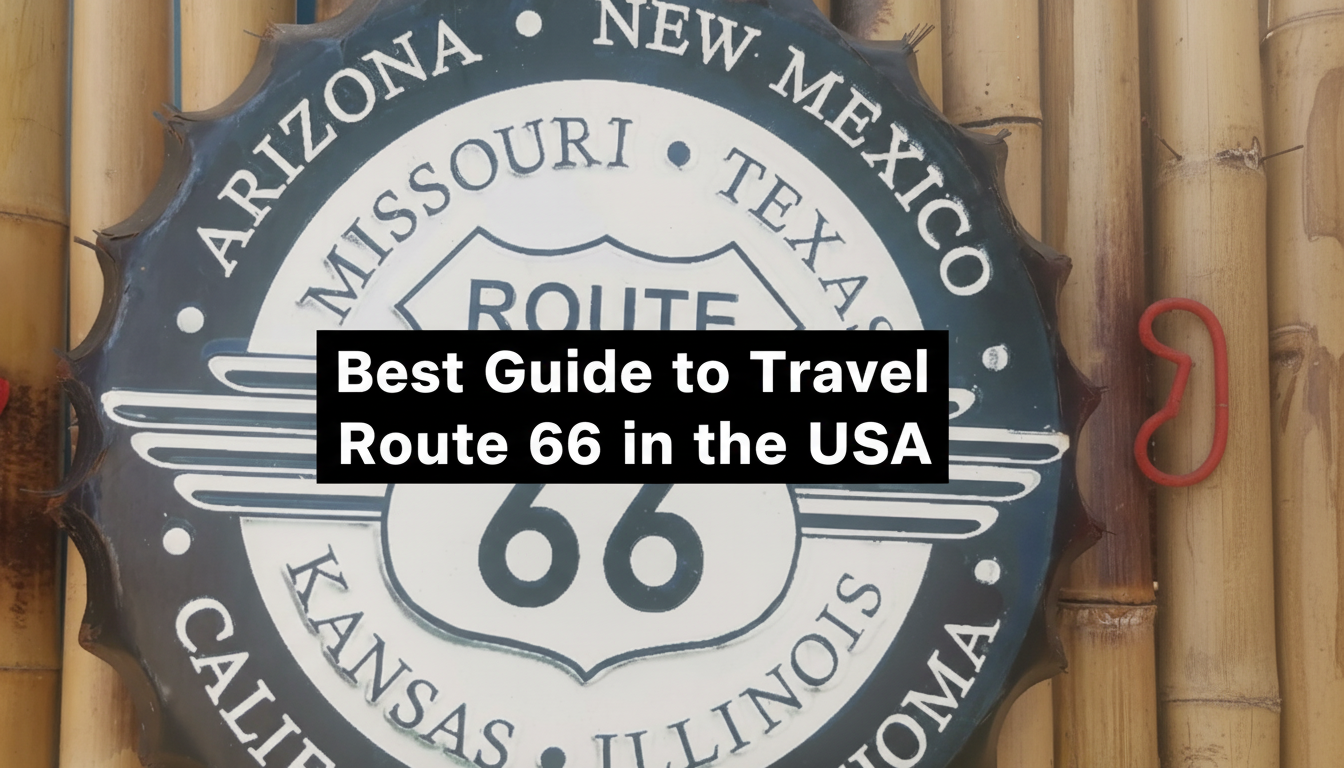In the United States, travelling Route 66 is more than just a road trip—it’s an adventure through history, American culture, and time. This famous route, which stretches 2,400 miles over eight states from Chicago, Illinois, to Santa Monica, California, provides tourists with a window into the spirit and essence of the United States. Route 66 has always had a particular place in the hearts and minds of travelers and explorers everywhere, from its start as a crucial transportation route during the Great Depression to its current status as a mythical representation of the American road trip.
Known by many as the “Main Street of America,” Route 66 was one of the first routes built as part of the U.S. Highway System in 1926. It connected rural and urban areas across the nation and was a major route for migration westward, trade, and tourism. As thousands of Americans looked for work during the Dust Bowl and the Great Depression in the 1930s, Route 66 became well-known. The highway, which offered adventure and promise to those who followed its illustrious route, came to represent the American Dream.
Route 66 is still associated with adventure, liberty, and wide-open spaces today. Sections of Route 66 remain, maintained as historic sites and picturesque byways, despite the fact that the majority of the original roadway has been replaced by contemporary interstate roads. Route 66 transports travelers to a bygone era through its neon signs, roadside eateries, and historic motels. It’s like taking a trip back in time.
Route 66 travel is as much about the stops along the way as it is about the travel itself. Route 66 offers an array of experiences and sights spanning from the sun-drenched coasts of California to the bustling streets of Chicago. Famous sites including the Grand Canyon in Arizona, the Cadillac Ranch in Amarillo, and the Gateway Arch in St. Louis are open for exploration by tourists. Along the way, they can visit eccentric roadside attractions, indulge in local food at wayside diners, and learn about the rich cultural legacy of the communities.
The portion of Route 66 in Arizona known as the “Mother Road” is one of the most well-known sections of the highway. Travelers’ can explore the Petrified Forest National Park, drive through the Painted Desert, and take in the breath-taking views of the surrounding scenery. Route 66 in New Mexico winds through ancient communities like Santa Fe and Albuquerque, where visitors may discover lively art scenes, Native American culture, and adobe architecture.
Traveler’s are rewarded with expansive views of towering mesas, untamed landscapes, and rolling plains as Route 66 runs through the heartland of the United States. They can encounter the friendliness and warmth of small-town America along the way, where the people are happy to share their customs and tales.
Route 66 is more than simply a roadway; it represents tenacity, resourcefulness, and the spirit of the pioneer that characterizes the American experience. Route 66 offers a chance to enjoy the eternal appeal of the open road, celebrate the present, and establish connections with the past. Route 66 provides an amazing excursion through the heart of America, whether you’re travelling by motorbike, historic automobile or contemporary road trip. In this article, we will give you the best information for traveling the Route 66 in the United States.
In this article, we will give you our advice and a guide to making your trip on the route 66 the best travel experience.
Chicago, Illinois
The famous cross-country route begins in Chicago, Illinois, which is also the eastern terminus of Route 66. Chicago, one of the biggest and liveliest cities in the US, provides visitors with an exciting fusion of attractions, culture, and history.
Known as the “Windy City,” Chicago is home to a famous skyline that is broken up by towering skyscrapers like the John Hancock Centre and the Willis Tower, which was originally known as the Sears Tower. With its well-known Cloud Gate sculpture, Millennium Park is a well-liked hangout for people looking for outdoor activities, greenery, and art.
From the lively alleyways of Chinatown to the historic architecture of the Loop to the exciting nightlife of Wicker Park, the city’s varied neighborhoods showcase its rich cultural legacy. With a flourishing culinary culture that features everything from deep-dish pizza and Chicago-style hot dogs to upscale dining experiences, Chicago is also a food lover’s paradise.
Chicago has a plethora of historical sites and museums for history buffs to discover. The Field Museum features displays on natural history and anthropology, while the Art Institute of Chicago is home to a vast collection of artworks spanning centuries and countries. The Chicago History Museum sheds light on the past of the city, highlighting its significance as a center for immigration, industry, and transportation.
Chicago is the starting point of Route 66, signifying the start of an exciting journey full of exploration, adventure, and wide roads. Travelers may immerse themselves in the vibrant culture of Chicago, explore its iconic landmarks, and experience its diverse cuisine, all of which offer an incredible introduction to the essence of Route 66.
If you would like to know What to do and see in Chicago, click here go to our post where you will receive the best information and some of our recommendations.
St. Louis, Missouri
Travelers visiting St. Louis, Missouri, can get a view of the American heartland at this historic waypoint on Route 66. Known as the gateway to the West, St. Louis is home to a thriving cultural legacy, recognizable buildings, and lively neighborhoods that all contribute to its status as a hub for trade, transportation, and culture.
A prominent landmark in St. Louis, the Gateway Arch is a towering monument made of stainless steel that represents the city’s historical significance as the “Gateway to the West.” A museum at the foot of the arch that chronicles America’s westward progress is open to visitors, or they can take a ride to the top for sweeping views of the city and Mississippi River.
Apart from the Gateway Arch, St. Louis provides a plethora of sites for tourists to discover. One of the biggest zoos in the country, the St. Louis Zoo is housed in the lovely Forest Park and has thousands of animals from hundreds of species from across the globe. The Missouri History Museum and the St. Louis Art Museum are just two of the many museums, parks, and leisure centers that may be found inside the vast urban paradise that is Forest Park.
St. Louis has a wealth of historical buildings and museums to explore for individuals who are interested in history and culture. With thousands of plant species from all over the world, the Missouri Botanical Garden is one of the oldest botanical gardens in the country, having been established in 1859. Exhibits at the St. Louis Science Centre, situated in Forest Park, are interactive and include everything from dinosaurs to space research.
All things considered, St. Louis is a lively and friendly destination off Route 66, providing visitors with a wide range of activities and events that honor the city’s rich history and culture.
Springfield, Missouri
The town of Springfield, Missouri, is particularly important along Route 66, sometimes known as the “Mother Road.” Springfield, one of the major hubs on this famous roadway, captures the spirit of America with its lively culture, historic sites, and friendly people.
The nostalgic appeal and rich history of Springfield entice visitors travelling along Route 66. The community, which is home to the Route 66 Car Museum, proudly displays its heritage as the original location of the well-known roadway. Here, guests can lose themselves in the romance of the open road while admiring a collection of vintage automobiles and motorcycles that capture the essence of a bygone period.
A must-visit location for fans, the Birthplace of Route 66 Roadside Park is another gem of Springfield’s Route 66 heritage. Through educational plaques and exhibits, visitors may learn about the history and significance of the roadway at this historic site, which has a reproduction of the famous Route 66 sign.
Beyond the attractions along Route 66, Springfield has a lot to offer tourists in terms of culture and entertainment. At places like the Springfield Art Museum, where guests may view a varied collection of artworks spanning many genres and time periods, the city’s thriving arts sector is on display.
Outdoor enthusiasts will also have no shortage of things to explore in Springfield; the Ozark Mountains and Table Rock Lake, two neighboring natural landmarks, provide hiking, fishing, and boating options amidst stunning landscape.
All things considered, Springfield, Missouri, is a classic Route 66 destination that welcomes visitors to lose themselves in the romance and nostalgia of the country’s most well-known road. Whether touring its natural beauties, cultural hotspots, or historic sites, travelers are bound to be enthralled with Springfield’s ageless appeal and the resilient spirit of Route 66.
Tulsa, Oklahoma
Tulsa, Oklahoma, is a bustling city that offers visitors a unique combination of cultural diversity, historical history, and contemporary conveniences. It is tucked away along the historic Route 66. Tulsa, a major hub on the famous highway, has a plethora of sites and structures that honor its history as a Route 66 city and highlight its distinct beauty.
The Cyrus Avery Plaza, named for the “Father of Route 66” who was instrumental in the construction of the highway, is one of Tulsa’s most recognizable Route 66 icons. With a bronze statue of Cyrus Avery and a number of historical markers and inscriptions honoring the highway’s significance, this plaza pays homage to the legacy of Route 66.
The Blue Dome District, a historic neighborhood in Tulsa that is well-known for its unusual blue dome building that was formerly a petrol station along Route 66, is another must-see location. The Blue Dome District is now a well-liked hangout for both locals and tourists, with its unique stores, cutting-edge eateries, and exciting nightlife.
The Tulsa Route 66 Interpretive Centre is another one of Tulsa’s Route 66 attractions. Here, visitors may discover the history and significance of the route with interactive exhibits and displays. The city also has a wide range of galleries, museums, and other cultural organizations that provide insights into Tulsa’s rich history and identity.
Beyond the attractions along Route 66, Tulsa has a lot to offer tourists. From cultural events and festivals honoring the city’s music and art culture to outdoor recreation possibilities along the Arkansas River, there is something for everyone to enjoy. Tulsa, Oklahoma, is a mesmerizing destination along Route 66 that welcomes visitors to explore its numerous treasures and experience the spirit of the open road. It is known for its distinctive blend of history, culture, and hospitality.
Oklahoma City, Oklahoma
Route 66 passes through Oklahoma City, which is a major destination that offers visitors a plethora of landmarks, sights, and experiences honoring the route’s cultural significance and rich history. The capital of Oklahoma, Oklahoma City, is a must-see location for anyone travelling Route 66 because of its dynamic fusion of Western charm and metropolitan sophistication.
The historic Bricktown neighborhood, a resurrected entertainment and dining area in the center of Oklahoma City, is one of the most noteworthy Route 66 landmarks. Bricktown, which was formerly a thriving warehouse neighborhood, is now a well-liked hangout for both locals and visitors since it has a wide range of eateries, bars, stores, and entertainment options.
The Oklahoma Route 66 Museum, which is situated in Clinton, is another of Oklahoma City’s Route 66 attractions. This museum features exhibits and displays that highlight the highway’s influence on Oklahoma and the country at large, giving visitors a thorough look at the history and culture of Route 66.
Oklahoma City provides visitors with a wide range of cultural and recreational options to enjoy in addition to its Route 66 monuments. At locations like the Oklahoma City Museum of Art and the Oklahoma City National Memorial & Museum, which honors the victims of the 1995 Oklahoma City bombing, the city’s thriving artistic community is on display.
Oklahoma City has a lot to offer outdoor enthusiasts as well, with parks, trails, and recreational areas providing chances for riding, hiking, and other outdoor sports. Travelers are invited by Oklahoma City to embrace the spirit of the open road and feel the warmth and hospitality of the American West, whether they are visiting its Route 66 landmarks, cultural attractions, or natural wonders.
Amarillo, Texas
Travelers can experience a distinctive fusion of Texan charm, Western hospitality, and Route 66 nostalgia in Amarillo, Texas, a bustling city situated along the famous Route 66. Amarillo, one of the most recognizable highway stops, offers a wide range of sites, experiences, and activities that honor its Route 66 history and highlight its dynamic culture.
Situated to the west of the city, the Cadillac Ranch is a distinctive art piece and one of Amarillo’s most well-known attractions. Cadillac Ranch is a 1974 art project by the Ant Farm, which consists of ten Cadillac vehicles buried nose-first in the earth with their tailfins sticking out. It is open for visitors to explore, leave their graffiti mark, and
The Big Texan Steak Ranch, a famous roadside attraction and steakhouse that has been serving up Texas-sized steaks since 1960, is another must-see place in Amarillo. The eatery is well-known for its 72-ounce steak challenge, in which patrons try to finish a huge steak in under an hour in order to win honors and free food.
The Route 66 Historic District, a section of the roadway dotted with historic motels, restaurants and petrol stations that harken back to a bygone era, is another one of Amarillo’s Route 66 attractions. Strolling down the old streets, taking in the neon signs, and imagining themselves travelling Route 66 in its glory are all available to visitors.
Amarillo provides visitors with a wide range of cultural and recreational options to explore, from parks and outdoor attractions to museums and galleries, in addition to its Route 66 relics. Travelers may experience the charm and excitement of Route 66 in true Texas style by visiting Amarillo, where they can explore its iconic roadside attractions, indulge in the local cuisine, and immerse themselves in its Western heritage.
Albuquerque, New Mexico
Situated along the historic Route 66, the dynamic city of Albuquerque, New Mexico, captivates visitors with a unique blend of natural beauty, Southwestern culture, and nostalgia for the old Route 66. Albuquerque, one of the most recognizable highway stops, offers a wide range of activities, sights, and experiences that honor its Route 66 history and highlight its vibrant cultural past.
Situated along Central Avenue, which was the original Route 66 alignment, the historic Nob Hill section is a lovely neighborhood and one of the most recognizable Route 66 sites in Albuquerque. Nob Hill is well-known for its unique neon signs, vintage architecture, and eclectic mix of eateries, stores, and galleries. Tourists can enjoy the nostalgic atmosphere of this famous section of Route 66 by strolling down Central Avenue and perusing the boutiques.
The historic Old Town, a Spanish colonial settlement that predates the city’s establishment in 1706, is another must-see location in Albuquerque. Cobblestone streets, old adobe structures, and charming stores offering authentic Southwestern goods and mementos may all be found in Old Town. Explore the San Felipe de Neri Church, go to the Albuquerque Museum, or dine at one of the neighborhood eateries to try some New Mexican food.
The famous Route 66 Diner, a typical American diner that honours the highway’s glory days with its retro decor and menu of comfort food favourites, is another of Albuquerque’s Route 66 attractions. Indulge in burgers, shakes, and fries while soaking in the nostalgic ambiance of this well-liked roadside restaurant.
Albuquerque provides visitors with a wide range of cultural and recreational options to explore, from parks and outdoor attractions to museums and galleries, in addition to its Route 66 icons. Travelers are invited to enjoy the charm and fascination of Route 66 in authentic South-western style in Albuquerque, whether they choose to explore its historic neighborhoods, savor the regional cuisine, or take in its breath-taking natural beauty.
Flagstaff, Arizona
Nestled amidst the scenic surroundings of northern Arizona, Flagstaff, Arizona, is a little community that offers a mesmerizing stopover along the historic Route 66. Flagstaff, a city well-known for its breathtaking natural beauty, extensive history, and lively culture, provides visitors with a wide range of experiences and attractions that honor its Route 66 roots while highlighting its distinct charm.
The historic downtown section in Flagstaff, a thriving center of stores, eateries, and art galleries situated along the original Route 66 route, is one of the most recognizable Route 66 sights. Wander the charming streets, take in the historic buildings, and discover the unique assortment of shops and restaurants that adorn the path.
The Museum of Northern Arizona, which provides tourists with an enthralling look into the area’s natural history, Native American cultures, and pioneer legacy, is another must-see attraction in Flagstaff. Exhibits at the museum illustrate the unique cultural diversity and ecological relevance of northern Arizona through artefacts, artwork, and interactive displays.
Among the well-known Route 66 attractions in Flagstaff is the vibrant Route 66 Shield mural, which is painted on the side of a historic building in the city’s downtown. This artwork honors the history of the highway and is a well-liked location for tourists to take pictures while they are in the neighborhood.
Apart from its Route 66 attractions, Flagstaff provides visitors with an array of outdoor recreational possibilities to experience, ranging from skiing and snowboarding at the Arizona Snowbowl ski resort to hiking and mountain biking in the neighboring Coconino National Forest. Discover the charm and intrigue of Route 66 in the middle of Arizona’s breathtaking scenery by travelling through Flagstaff’s historic downtown, engaging in its cultural offerings, or going on outdoor activities.
Santa Fe, New Mexico
Santa Fe, New Mexico, a city situated along the famous Route 66, is a charming, culturally diverse, and historically rich city. One of the most recognisable destinations along the historic roadway, Santa Fe provides visitors with a distinctive fusion of artistic flare, Southwestern warmth, and nostalgia for the Route 66.
Santa Fe’s historic central square, a bustling centre of stores, galleries, and eateries reflecting the city’s rich cultural legacy, is one of its most famous attractions. Discover the adobe architecture, peruse Native American handicrafts, and savour the regional cuisine as you take in the vibrant atmosphere of this well-liked location.
The Georgia O’Keeffe Museum, which honours the life and creative output of the well-known American artist who made New Mexico his home, is another must-see location in Santa Fe. A wide range of O’Keeffe’s paintings, sketches, and sculptures are on display in the museum’s collection, giving visitors an understanding of her artistic vision and creative process.
Among the other notable sights along Route 66 in Santa Fe is the historic La Fonda hotel, which has been welcoming guests since 1922. Situated in close proximity to the plaza, La Fonda offers sophisticated lodging, exceptional dining options, and a fascinating past that transports guests to the heyday of Route 66.
Apart from the attractions along Route 66, Santa Fe provides tourists with an array of cultural and recreational options to savor, ranging from galleries and museums to outdoor experiences in the neighboring mountains and deserts. Santa Fe welcomes visitors to experience the charm and appeal of Route 66 in the center of the Southwest, whether they want to take in the natural beauty of the surrounding landscapes or the art, architecture, and history of the city.
Las Vegas, Nevada
Nestled along the storied Route 66 lies the culturally rich city of Las Vegas, New Mexico. Though it is sometimes eclipsed by its more well-known namesake in Nevada, Las Vegas, New Mexico, provides visitors with a distinctive fusion of Victorian architecture, Old West charm, and nostalgia for Route 66.
With a plethora of exquisitely preserved Victorian buildings and stores, Las Vegas’ historic downtown core is one of the city’s most noteworthy attractions. Experience the rich history and distinctive character of this energetic location by taking a leisurely stroll around the streets, admiring the elaborate facades, and exploring the stores, galleries, and cafes that line the path.
Travelers should also make time to view the Plaza Hotel in Las Vegas, a historic building that has been welcoming guests since the days of the Old West. The Plaza Hotel, which was constructed in 1882, is a picture of elegance and charm. Its classic design, vintage furniture, and contemporary conveniences provide guests with a window into the city’s colorful history.
A historic relic situated just outside the city, Montezuma Castle is another of Las Vegas’s Route 66 attractions. Originally constructed in the late 19th century as a posh hotel and spa, this impressive building has also been used as a movie set and a military academy. Today, guests may stroll around the castle’s grounds, take in its stunning architecture, and discover more about its interesting past through exhibits and guided tours.
Apart from the attractions along Route 66, Las Vegas provides tourists with an array of outdoor recreational choices to enjoy, ranging from strolling around the city’s parks, trails, and picturesque views to hiking and fishing in the neighboring mountains and rivers. Travelers are invited to experience the charm and allure of Route 66 in the heart of the Southwest by visiting Las Vegas, New Mexico, where they may explore its historic downtown, take in its Victorian architecture, or just take in the Old West vibe.
San Bernardino, California
As a major hub for visitors passing through the western sections of the famous roadway, San Bernardino, California, is a notable location along the historic Route 66. San Bernardino, one of the most recognizable places along the California stretch of Route 66, provides tourists with an intriguing fusion of culture, history, and scenic beauty.
Situated in the city’s historic downtown core, the California Route 66 Museum is one of San Bernardino’s most noteworthy attractions. With displays, relics, and memorabilia that emphasize the highway’s influence on California’s growth and identity, this museum highlights the rich historical and cultural relevance of Route 66. Discover roadside sites, have a look at classic cars, and become lost in the nostalgia of Route 66’s bygone era.
The historic McDonald’s Museum, which honors the location of the first McDonald’s restaurant ever, is another must-see attraction in San Bernardino. This well-known fast-food franchise, which was founded in 1940 by brothers Richard and Maurice McDonald, transformed the restaurant business and came to represent American culture. The museum has displays on the history of McDonald’s, which include old-fashioned signs, souvenirs, and images that chronicle the development of this cherished company.
The historic Wigwam Motel is another one of San Bernardino’s Route 66 attractions. It’s a unique roadside lodging option where visitors may sleep in cabins built like teepees. Constructed in the 1940s, the Wigwam Motel is a quintessential illustration of mid-century roadside architecture and a well-liked location for tourists to take pictures while they’re in the region.
San Bernardino provides tourists with a wide range of cultural and recreational options to explore, from parks and outdoor attractions to museums and galleries, in addition to its Route 66 relics. Travelers are invited to experience the charm and appeal of Route 66 in the center of Southern California by visiting San Bernardino’s historic landmarks, marveling at its architectural treasures, or taking in its breathtaking natural beauty.
Santa Monica, California
The famous Route 66 comes to an end in Santa Monica, California, which is the last stop for many travelers starting the historic cross-country adventure. Santa Monica, the terminus of the “Mother Road,” is particularly dear to Route 66 enthusiasts since it provides a vibrant fusion of coastal beauty, cultural diversity, and nostalgia for the ancient road.
The Santa Monica Pier, a famous seaside location that has drawn tourists since the early 20th century, is one of the city’s most recognizable sights. The pier is a well-liked destination for both locals and visitors since it has a historic carousel, an amusement park, and a range of shops and restaurants. At the end of the pier, guests are able to view expansive
The Route 66 “End of the Trail” sign, which is situated close to the pier, is another must-see sight in Santa Monica. This famous sign, which denotes the official end of Route 66, represents the accomplishment of many passengers’ dreams as well as the conclusion of the cross-country trip. In addition to reflecting on their voyage and celebrating their success in reaching the Pacific Ocean, visitors can snap pictures with the sign.
Among the other attractions on Route 66 in Santa Monica is the historic Ocean Avenue, a picturesque promenade dotted with posh stores, hip eateries, and palm trees. Wander the streets, take in the views of the water, and feel the lively atmosphere of this well-known seaside town.
Santa Monica provides tourists with a wide range of cultural and recreational options to explore, from parks and outdoor attractions to museums and galleries, in addition to its Route 66 relics. Explore Santa Monica’s historic sites, take in its rich culture, or simply enjoy its stunning coastline—travelers are welcome to immerse themselves in the enchantment and appeal of Route 66 in the heart of Southern California.





















